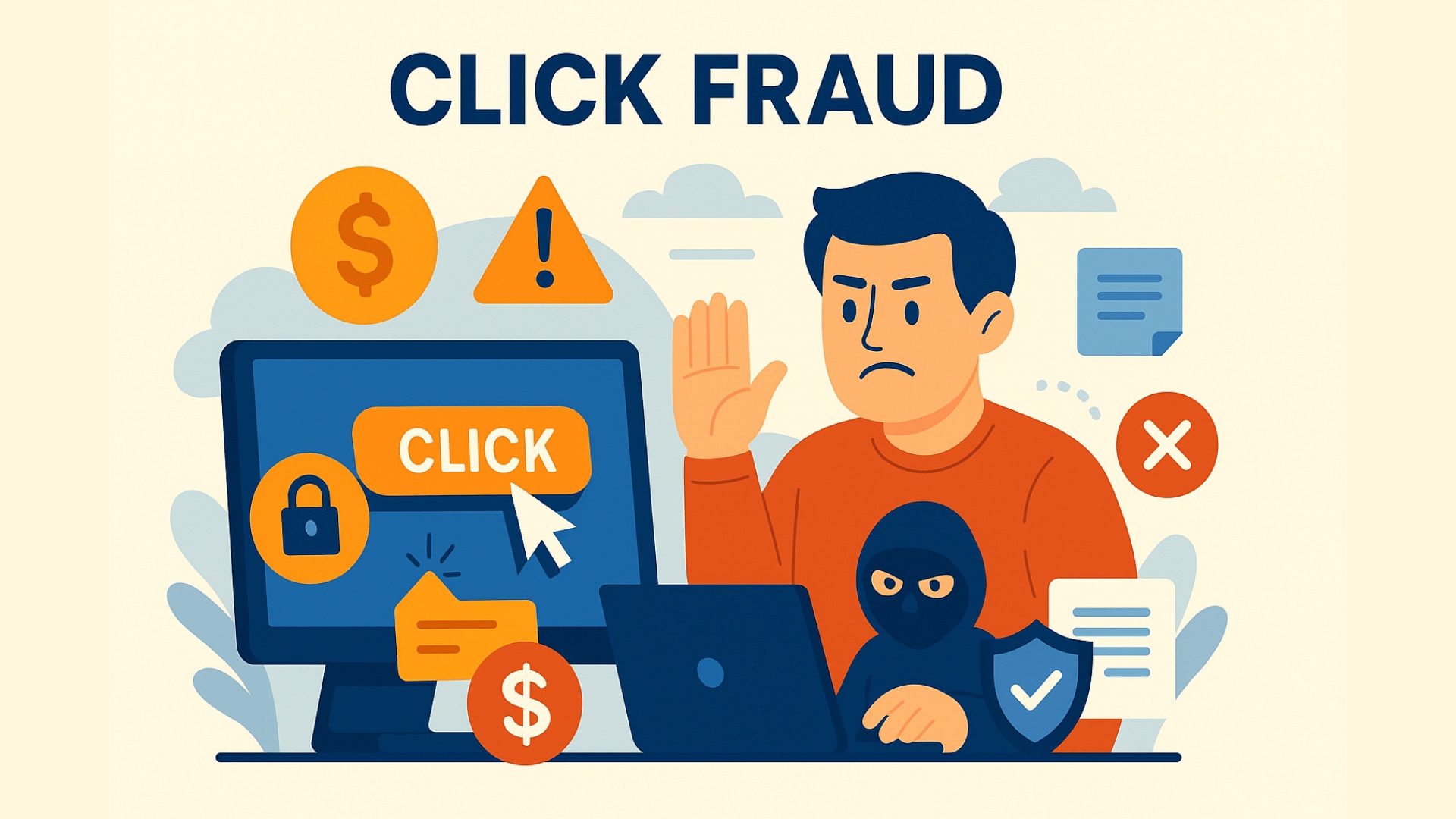
Click fraud continues to undermine the digital advertising landscape, siphoning billions from marketing budgets through deceptive and illegitimate ad interactions. As businesses increasingly rely on pay-per-click (PPC) advertising to attract customers and drive growth, fraudulent actors — including bots, click farms, and unethical competitors — exploit these systems by generating fake clicks that lead to no conversions and skew campaign data. These false interactions not only drain valuable ad spend but also compromise the integrity of performance metrics and diminish confidence in the effectiveness of digital advertising channels.
For website operators, IT managers and marketing decision-makers, understanding click fraud is no longer optional. It’s essential for maintaining campaign integrity, protecting digital infrastructure, and ensuring a positive return on advertising spend (ROAS). This guide dives deep into the mechanics, motivations, types, and countermeasures of click fraud — and how to stay one step ahead.
Table of contents
Understanding Click Fraud
Click fraud occurs when someone intentionally clicks on a digital ad without any interest in the product or service behind it. These invalid clicks are not accidental — they are designed to either drain the advertiser’s budget or generate illegitimate income for someone running the ad on their site.
Unlike genuine user interactions, fraudulent clicks — also known as fake ad traffic or PPC fraud — don’t lead to conversions. Instead, they inflate click-through rates (CTR), skew performance analytics, and can sabotage digital strategies.
Motivations vary widely. Sometimes, it’s about financial gain — especially in cases where a publisher earns money per click. In other scenarios, it’s competitive sabotage: businesses deliberately clicking on rival ads to exhaust their marketing budgets.
Click Fraud Techniques and Tools
Fraudsters use a range of tactics, from basic to highly sophisticated. One common method involves bots — automated scripts designed to mimic real users. These bots may vary their IP addresses, use different user agents, or simulate clicks at irregular intervals to evade detection.
More advanced fraud networks operate botnets: thousands of infected devices controlled remotely to launch click campaigns at scale. Because botnets distribute traffic across multiple geolocations and devices, distinguishing them from real users becomes much more difficult.
Click farms present another threat. These operations, often located in low-wage regions, employ real humans who manually click on ads. While resource-intensive, this method makes fraud harder to detect because it imitates genuine browsing behavior.
Other less obvious methods include:
- Pixel stuffing: where ads are crammed into 1×1 pixel spaces invisible to users but still register as impressions or clicks.
- Ad stacking: layering multiple ads on top of each other so a single click registers across several ad units.
- Geotargeted click fraud: simulating traffic from high-value regions to further manipulate campaign results.
Cost and Consequences of Click Fraud
Click fraud is not just a financial inconvenience; it’s a strategic threat. Industry estimates suggest digital ad fraud — including click fraud — could cost businesses over $170 billion annually by 2029.
The most immediate impact is budget loss. When a significant portion of clicks come from non-genuine users — whether bots or ad click abuse from competitors — your advertising dollars are being wasted. This decreases return on investment (ROI) and makes campaign performance look better or worse than it really is.
Beyond wasted spend, click fraud pollutes your analytics. With fake ad traffic distorting metrics like CTR, conversion rate, and cost-per-acquisition, marketing teams may make misguided decisions — scaling ineffective campaigns or cutting back on successful ones.
There are also reputational and operational risks. A company perceived as vulnerable to fraud may lose the trust of partners and customers. Server infrastructure can become overwhelmed by high volumes of bot-generated clicks, causing performance issues or even outages. And attackers probing your ad stack may use click fraud as a gateway to identify deeper vulnerabilities in your web infrastructure.
Types of Click Fraud
Click fraud can be broadly categorized into a few main types:
- Manual Click Fraud: Carried out by humans, often in click farms, this method uses actual users to interact with ads.
- Automated Click Fraud: Involves bots and scripts programmed to click on ads without human intervention.
- Publisher Fraud: Website owners hosting PPC ads click on their own ads or employ methods to simulate engagement in order to increase earnings.
- Competitor Click Fraud: Rival businesses deliberately clicking on your ads to deplete your advertising budget.
Each type requires a slightly different detection and prevention strategy.
Signs of Click Fraud
Detecting click fraud isn’t always straightforward, but certain warning signs often indicate a problem:
- A sharp increase in click volume without a corresponding rise in conversions
- Abnormally high CTRs that don’t match past trends
- Sudden traffic spikes from regions outside your target audience
- Very short session durations or high bounce rates
- Repeated clicks from the same IP address or device fingerprint
Analyzing ad performance in detail can help identify these red flags early.
How to Prevent Click Fraud
Effective prevention starts with a multi-layered approach. First, consider investing in specialized ad fraud detection software. These tools use behavioral analytics and machine learning to detect non-human patterns and block invalid clicks in real time.
Monitor campaign performance closely. Track engagement metrics like time on site, session depth, and conversion rates. Discrepancies between high click numbers and low engagement often point to fake PPC traffic or click injection schemes.
Set IP exclusions and geo-targeting filters to block traffic from suspicious sources. Where possible, use device fingerprinting to spot repeated interactions from the same configuration.
Regularly audit your campaigns, especially those with unusually high CTRs or inconsistent ROI. Use negative keyword lists and ad placement exclusions to avoid low-quality traffic sources.
CAPTCHA tools also play a key role. By requiring users to prove their humanity, CAPTCHA prevents bots from clicking ads or filling out lead forms. GDPR-compliant solutions like those from captcha.eu are especially effective in blocking automated click attempts without degrading user experience.
Role of CAPTCHA in Click Fraud Prevention
Automated click fraud is heavily dependent on bots and scripts that rapidly interact with ads. CAPTCHA solutions create friction in this process by challenging suspicious traffic and distinguishing bots from real users. They’re particularly effective when integrated at points of vulnerability: login pages, contact forms and pay-per-click landing pages.
Captcha.eu offers GDPR-compliant CAPTCHA tools designed to protect businesses from automated threats. By reducing bot-driven clicks, our solutions help ensure that advertising budgets are spent reaching real, valuable users — while safeguarding performance data.
Conclusion
Click fraud poses a serious threat to any business investing in online advertising. Its effects range from wasted budget and inaccurate analytics to damaged reputation and compromised web performance. But with the right knowledge and proactive strategies, you can defend your campaigns and maximize your ROI.
By leveraging fraud detection tools, analyzing traffic patterns, and deploying protective technologies like CAPTCHA, you place barriers between your ad budget and malicious activity.
At captcha.eu, we help businesses build that barrier. With robust, user-friendly, and GDPR-aligned CAPTCHA solutions, we support your efforts to keep digital threats at bay — so your campaigns reach real people, not fake clicks.
FAQ – Frequently Asked Questions
What is click fraud in online advertising?
Click fraud refers to the act of clicking on pay-per-click (PPC) ads with malicious or deceptive intent. These invalid clicks are often performed by bots, click farms or competitors with the goal of draining ad budgets or manipulating campaign performance metrics.
How can I tell if my ads are affected by click fraud?
Common signs include unusually high click-through rates (CTR) without conversions, traffic spikes from unfamiliar regions, repeated clicks from the same IP addresses, and short session durations. Analyzing campaign data regularly can help uncover these patterns.
Is click fraud illegal?
Click fraud can be considered illegal, especially if it results in financial harm or violates advertising platform policies. However, prosecuting it can be difficult due to the anonymity and global distribution of perpetrators.
What tools help prevent click fraud?
Advertisers can use fraud detection software, IP blocking, geotargeting controls, and device fingerprinting to reduce risks. CAPTCHA tools like those offered by captcha.eu also help block automated bot clicks by verifying user authenticity in real time.
What is the difference between click fraud and impression fraud?
Click fraud involves fake interactions with ads (clicks), while impression fraud involves fake views or loading of ads without any genuine user engagement. Both tactics aim to manipulate ad systems and extract revenue illegitimately.
100 free requests
You have the opportunity to test and try our product with 100 free requests.
If you have any questions
Contact us
Our support team is available to assist you.




